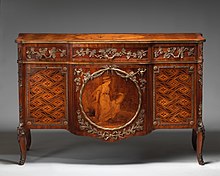This article needs additional citations for verification. (February 2015) |


A commode is any of many pieces of furniture. The Oxford English Dictionary has multiple meanings of "commode". The first relevant definition reads: "A piece of furniture with drawers and shelves; in the bedroom, a sort of elaborate chest of drawers (so in French); in the drawing room, a large (and generally old-fashioned) kind of chiffonier." The drawing room is itself a term for a formal reception room, and a chiffonier is, in this sense, a small sideboard dating from the early 19th century.
Another meaning attested is a washstand, a piece of furniture equipped with basin, jug, and towel rail, and often with space to store the chamber pot behind closed doors. A washstand in the bedroom pre-dates indoor bathrooms and running water.
In British English, "commode" is the standard term for a commode chair, often on wheels, enclosing a chamber pot—as used in hospitals and assisted living homes.[1] In the United States, a "commode" is now a colloquial synonym for a flush toilet.[2]
The word commode comes from the French word for "convenient" or "suitable", which in turn comes from the Latin adjective commodus, with similar meanings.
- ^ "Cambridge Dictionaries online, entry for Commode". Retrieved 20 January 2013.
- ^ Robinson, Melia (June 1, 2017). "I tried the 'Mercedes Benz of toilets' that comes with a remote control and costs $10,200". Business Insider. Retrieved 23 November 2017.
...But Japan's biggest toilet maker has brought these high-tech features and more to its premiere line of commodes.